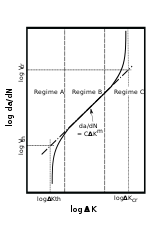Paris' law
Paris' law (also known as the Paris–Erdogan equation) is a crack growth equation that gives the rate of growth of a fatigue crack. The stress intensity factor characterises the load around a crack tip and the rate of crack growth is experimentally shown to be a function of the range of stress intensity seen in a loading cycle. The Paris equation is[1]

where is the crack length and is the fatigue crack growth for a load cycle . The material coefficients and are obtained experimentally and also depend on environment, frequency, temperature and stress ratio.[2] The stress intensity factor range has been found to correlate the rate of crack growth from a variety of different conditions and is the difference between the maximum and minimum stress intensity factors in a load cycle and is defined as
Being a power law relationship between the crack growth rate during cyclic loading and the range of the stress intensity factor, the Paris–Erdogan equation can be visualized as a linear graph on a log-log plot, where the x-axis is denoted by the range of the stress intensity factor and the y-axis is denoted by the crack growth rate (see Figure 1).
The equation gives the growth for a single cycle. Single cycles can be readily counted for constant-amplitude loading. Additional cycle identification techniques such as rainflow-counting algorithm need to be used to extract the equivalent constant-amplitude cycles from a variable-amplitude loading sequence.
History
In a 1961 paper, P. C. Paris introduced the idea that the rate of crack growth may depend on the stress intensity factor.[3] Then in their 1963 paper, Paris and Erdogan indirectly suggested the equation with the aside remark "The authors are hesitant but cannot resist the temptation to draw the straight line slope 1/4 through the data..." after reviewing data on a log-log plot of crack growth versus stress intensity range.[4] The Paris equation was then presented with the fixed exponent of 4.
Domain of applicability
Stress ratio
Higher mean stress is known to increase the rate of crack growth and is known as the mean stress effect. The mean stress of a cycle is expressed in terms of the stress ratio which is defined as
or ratio of minimum to maximum stress intensity factors. In the linear elastic fracture regime, is also equivalent to the load ratio
The Paris–Erdogan equation does not explicitly include the effect of stress ratio, although equation coefficients can be chosen for a specific stress ratio. Other crack growth equations such as the Forman equation do explicitly include the effect of stress ratio, as does the Elber equation by modelling the effect using crack closure.
Intermediate stress intensity range
The Paris–Erdogan equation holds over the mid-range of growth rate regime as shown in the figure 1, but does not apply for very low values of approaching the threshold value , or for very high values approaching the material's fracture toughness, . The alternating stress intensity at the critical limit is given by as shown in the figure 1.[5]
The slope of the crack growth rate curve on log-log scale denotes the value of the exponent and is typically found to lie between and , although for materials with low static fracture toughness such as high-strength steels, the value of can be as high as .
Long cracks
Because the size of the plastic zone is small in comparison to the crack length, (here, is yield stress), small-scale yielding applies, enabling the use of linear elastic fracture mechanics and the stress intensity factor. Thus, the Paris–Erdogan equation is also only valid in the linear elastic fracture regime, under tensile loading and for long cracks.[6]
References
- "The Paris law". Fatigue crack growth theory. University of Plymouth. Retrieved 28 January 2018.
- Roylance, David (1 May 2001). "Fatigue" (PDF). Department of Materials Science and Engineering, Massachusetts Institute of Technology. Retrieved 23 July 2010.
- Paris,, P. C.; Gomez, M. P.; Anderson, W. E. (1961). "A rational analytic theory of fatigue". The Trend in Engineering. 13: 9–14.CS1 maint: extra punctuation (link)
- Paris, P. C.; Erdogan, F. (1963). "A critical analysis of crack propagation laws". Journal of Basic Engineering.
- Ritchie, R. O.; Knott, J. F. (May 1973). "Mechanisms of fatigue crack growth in low alloy steel". Acta Metallurgica. 21 (5): 639–648. doi:10.1016/0001-6160(73)90073-4. ISSN 0001-6160.
- Ekberg, Anders. "Fatigue Crack Propagation" (PDF). Retrieved 6 July 2019.